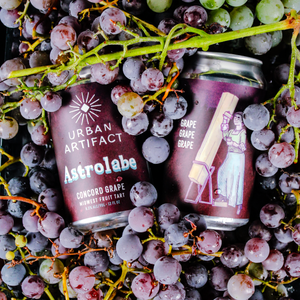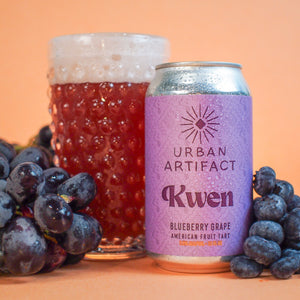Spontaneous fermentation was a new concept for me when I interviewed for the available brewer position at Urban Artifact in 2015. By the first warm spring day of that year, we had already collected and pasteurized over 100 jars of unfermented wort with the intention of leaving them open overnight in as many locations. The hope was that, by the next morning when the jars were collected and resealed, some would contain microbes which were both capable of fermenting wort into beer and also produced a palatable product. Very few of those, or the ensuing 600+ jars, have met both criteria; just over 1% across the life of the project as of November 2017.
Spontaneous fermentation is the process of making beer using wild yeast and bacteria that are floating in the air locally in and near the brewery. Using sterilized jars of brewer’s wort, we are effectively stacking the deck in our favor and only actively selecting the yeast and bacteria which work best for our desired purposes. The process of spontaneous fermentation was once thought to have been literally spontaneous, with wort randomly and mysteriously fermenting into beer, but with scientific investigation, humanity has since learned that this process is actually achieved through the action of yeast and bacteria. Given the unimaginable breadth of variety in the microbial world, spontaneously fermented beer has become the last true expression of terroir for any given location. It is simply not within our current technological capabilities to entirely recreate the microbial diversity from one location to another, which not only adds to the romantic uniqueness of spontaneously fermented projects, but it also implies a certain level of skill a brewer must possess in order to make a truly world-class product.
From the successful captures the Urban Artifact traditional wood-aged sour program was established. Similarly tasting wild-caught microbes were blended and selected for one of the three sour base beers we brew (one with rye, another with oats and the final with wheat). The best tasting and most thorough fermenters among these microbe blends were then used to inoculate more and more barrels as they were added to the program. Spring of 2017 brought about the first round of traditional sour beers, fermented solely with wild-caught microbes, which were of high enough quality to move on to the next step in the process: adding fruit.
Roughly two years after taking the initial steps in starting the wood-aged sour program, the first glimpse of what was to come finally became clear. The beautifully sour and complex beers which we had cared for for so long were finally dry and stable. Using the same focus on decadence and intensity which has guided the development of our line of Urban Legend beers, it seemed only reasonable to start at a fruit addition rate of 5 lbs per gallon. Minimum. By the end of May 2017, over half of a ton of both boysenberries and freshly-picked South Carolina peaches had been stuffed into only four oak barrels creating the first of our 100% spontaneously fermented barrel aged beers, Beipiaosaurus & Pteranodon respectively.
There are roughly less than 50 breweries, in the entire world, that currently produce spontaneous beers in some capacity. These beers, to us, constitute some of the world’s best liquids. Wild and barely tamed by a select cadre of brewers across the globe, these beers are the ultimate expression of a brewer’s creativity. To literally pull yeast and bacteria, at random, from the air, cultivate these microbes, curate their growth and development, and finally coax them into making world class beer is an experience that few brewers- and drinkers- ever get to enjoy. These beers are the epitome of unique; each barrel as special and different from each other as people are, yet still tied together through primarily yeast-driven fermentation. To us at Urban Artifact, this beer drinking experience is the apex of our overly romanticized beer drinking lives.
-Josh Elliott
Urban Artifact







